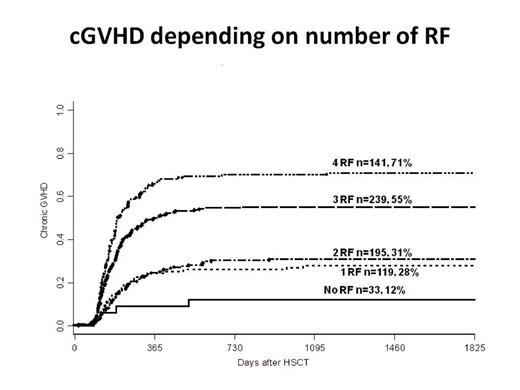Chronic Graft-versus-Host disease (cGVHD) remains a major cause of morbidity and mortality in long-term survivors after allogeneic hematopoietic stem cell transplantation (ASCT). Among the major risk factors previously noted is sex-mismatch, acute GVHD and peripheral hematopoietic blood stem cell grafts (PBSC). Our aim in this study was to determine risk factors for cGVHD and evaluate the impact of ATG on cGVHD in a multi-centre setting.
Patients from three centers (Stockholm, Sant Pau, Barcelona and Salamanca) were included. Retrospective data analysis was conducted for all patients (n=820) transplanted between 2000 and 2006. In our cohort 91% had malignant disease, 57% received HLA-identical sibling donor grafts, 13% received grafts with one HLA-A, -B or –DR antigen mismatch and 30% received grafts from HLA-A, -B and –DR matched unrelated donors. Reduced intensity conditioning was given to 65% of the patients. Chronic GVHD was classified according the National Institute of Health consensus criteria.
Overall incidence of cGVHD was 46% for patients surviving more than three months after ASCT (n=747). Older patient age HR 1.15 (95% CI 1.07-1.24), p<0.001, acute GVHD HR 1.30 (95% CI: 1.04-1.63), p=0.024, and reduced intensity conditioning (RIC) HR 1.36 (95% CI 1.04-1.79) p=0.028 were shown to significantly increase the risk of overall cGVHD in multivariate analysis. In addition, female donor to male recipient HR 1.43 (95% CI 1.07-1.92), p=0.02, RIC HR 1.65 (95% CI 1.18-2.30) p=0.003, and PBSC HR 1.90 (95% CI 1.14-3.16), p=0.01 significantly influenced the risk of moderate-to-severe cGVHD in multivariate analysis. For both overall and moderate-to-severe cGVHD, ATG had a protective effect with HR 0.41 (95% CI 0.32-0.52) p<0.001 and HR 0.32 (95% CI 0.23-0.46) p<0.00, respectively. Accordingly, we developed a scoring system including all variables influencing the risk of cGVHD in multivariate analysis allowing us to distinguish patient cohorts with 12% to 71% incidence of cGVHD (figure 1). Relapse free survival (RFS) was significantly impaired in the group with severe cGVHD. RFS was not affected significantly by the addition of ATG. All three centers had similar overall survival for patients with cGVHD.
RIC increases the risk for both overall and moderate to severe cGVHD. Acute GVHD and older recipient age are significant risk-factors for overall cGVHD and female donor to male recipient and PBSC for moderate to severe cGVHD. ATG significantly reduces the risk of all grades of cGVHD without having a negative outcome on RFS. Therefore, in order to prevent overall and moderate-extensive cGVHD it should be added to the RIC regimen in older patients and in male patients with female donors after PBSC grafts.
Ringden:Gilead : Invited to Gilead on July 28, 2011, to participate in an Advisory Board Meeting on Treatment of invasive fungal infection. Other. San Miguel:Jansen, Celgene, Onyx, Novartis, Millenium: Consultancy, Membership on an entity’s Board of Directors or advisory committees.


This feature is available to Subscribers Only
Sign In or Create an Account Close Modal